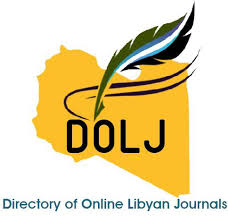Vitamin D and therapy of breast cancer
DOI:
https://doi.org/10.54361/Keywords:
breast cancer, cancer, analogues of vitamin D, LibyaAbstract
Breast cancer is one of the most widely distributed cancer diseases in women. Breast carcinomas derive from the epithelial lining of the milk ducts and the duct lobules. 1α, 25 dihydroxyvitamin D3 [1, 25(OH) 2D3], the biologically active form of vitamin D that interacts with vitamin D receptor. It prevents and inhibits the growth of breast cancer cells by arresting the cancer cells replication cycles, promoting apoptosis, inhibiting invasion, metastasis and angiogenesis. The mechanism of action is not well fully identified, the vitamin D modulate the expression of myc, fos, jun genes and up regulate of p53, Rb genes. In addition, it inhibits expression of aromatase enzyme through inhibiting production of cox-2 enzyme and increase expression of 15-hydroxyprostaglandin dehydrogenase. Although much of attention has been directed in recent years to development new analogous of vitamin D3 as potential therapeutic agent in breast cancer therapy, addition of vitamin D3 to chemotherapy has been found to potentiate their anticancer effect and associated with reduction of their toxicity. In this review, I try to emphasize the role of vitamin D3 in potentiating therapy of breast cancer.
Downloads
References
Jemal A, Bray F, Center MM, Ferlay J, Ward E and Forman D. Global cancer statistics. CA Cancer J Clin. 2011, 61; 2: 69-134.
National Cancer Institute. Breast cancer screening. cancer.gov/cancertopics/pdq/ screening/ breast/healthprofessional (Accessed on April 16, 2012).
Carlson RW, Allred DC, Anderson BO, Burstein HJ, Carter WB, Edge SB, et al. Breast cancer. Clinical practice guidelines in oncology. J Natl Compr Canc Netw. 2009, 7; 2: 122- 192.
Sariego J. Breast cancer in the young patient. Am Surgeon. 2010, 76; 12: 1397-1401.
Walters NR. Newly identified actions of the vitamin D endocrine system. Endocrin Revi. 1992, 13: 719-764.
Eisman JA, Marlin TJ, Maclntyre I and Moseley JM. 1, 25-dihydroxyvitamin D receptor in breast cancer cells. Lancet. 1979, 2: 1335-1336.
Eisman JA. 1, 25-Dihydroxyvitamin D3 receptor and role of 1, 25-(OH)2 D3 in human cancer cells. In: Kumar R, ed., vitamin D metabolism: basic and clinical aspects, pp. 365- 382. Martinus Nijhoff, the Hague, 1984.
Eisman JA, Suva LJ, Sher E, Pearce PJ, Funder JW and Martin TJ. Frequency of 1, 25- dihydroxyvitamin D3 receptor in human breast cancer. Cancer Res. 1981, 41: 5121-5124.
Berger U, McClelland RA, Wilson P, Greene GL, Haussler MR, Pike JW, Colston K, Easton D and Coombes RC. Immunocytochemical determination of estrogen receptor, progesterone receptor, and 1,25·dihydroxyvitamin D3 receptor in breast cancer and relationship to prognosis. Cancer Res. 1991, 51: 239-244.
Freake HC, Abeyasekera G, Iwasaki J, Marcoccl C, Maclntyre I, McClelland RA, Skilton, RA, Easton DF and Coombes RC. Measurement of 1, 25-dihydroxyvitamin D3 receptors in breast cancer and their relationship to biochemical and clinical indices. Cancer Res. 1984, 44: 1677-1681.
Colston KW, Berger U and Coombes RC. Possible role for vitamin D in controlling breast cancer cell proliferation. Lancet. 1989, 1: 188-191.
Pike JW. Vitamin D3 receptors: structure and function in transcription. Aunn Rev Nutr. 1991, 11: 189-216.
Darwish H and D e Luca HF. Vitamin D-regulated gene expression. Critical Rev. Eukaryotic Gene Expression. 1993, 3: 89-116.
Costa EM, Hirst MA and Feldman D. Regulation of l, 25-dihydroxyvitamine D3 receptors by vitamin D analogues in cultured mammalian cells. Endocrinol. 1985, 117: 2203-2210.
Krishnan AV and Feldman D. Stimulation of 1, 25-dihydroxyvitamin D3 receptor gene expression in cultured cells by serum and growth factors. J Bone Mineral Res. 1991, 6: 1099-1107.
Escaleira MTF , Sonohara S and Brentanl MM. Sex steroids induced up-regulation of 1, 25-(OH) 2 vitamin D3 receptors in T 47D breast cancer cells. J Steroid Biochem Molec Biol. 1993, 45: 257-263.
Furr BJA and Nicholson RI. Use of analogues of luteinizing-releasing hormone for treatment of cancer. J Reprod Fert. 1982, 64: 529-539.
Wilkinson JR, Williams JC, Singh D, Goss PE, Easton D and Coombes RC. Response of nitrosomethylurea-induced rat mammary tumors to endrocrine therapy and comparison with clinical response. Cancer Res. 1986, 46: 4862-4865.
Colston KW, Chander SK, Mackay AG and Coombes RC. Effects of synthetic vitamin D analogues on breast cancer cell proliferation in vivo and in vitro. Biochem Pharmacol. 1992, 44: 693-702.
Iino Y, Yoshida M, Sugamata N, Maemura H, Ohwada S, Yokoe T, Ishlkita T, Horiuchi R and Morishita Y. 1α-Hydroxyvitamin D3, hypercalcemia, and growth suppression of 7, 12- dimethylbenz[a] anthracene-induced rat mammary tumors. Breast Cancer Res Treat. 1992, 22: 133-140.
Saez S, Falette N, Gulllot C, Meggouh F, Lefebvre MF and Crepin M. 1, 25(OH) 2D3 Modulation of mammary tumor cell growth in vitro and in vivo. Breast Cancer Res Treat. 1993, 27: 69-81.
Steroids. 2012 Sep; 77(11):1107-12. doi: 10.1016/ j.steroids .2012.06.005. Epub 2012 Jul 16
Druker BJ, Mamon HJ and Roberts TM. Oncogenes, growth factors and signal transduction. N Engl J Med. 1989, 321: 1383-1391.
Studzinski GP. Oncogenes, growth, and the cell cycle: an overview. Cell Tissue Kin. 1989, 22: 405-424.
Travali S, Koniecki J, Petralia S and Baserga R. Oncogenes in growth and development. FASEB J. 1990, 4: 3209-3214.
Weinberg RA. Tumor suppressor genes. Science. 1991, 54: 1138-1145.
Hollingsworth RE and Lee WH. Tumor suppressor genes: new prospects for cancer research. J Natl Cancer Inst. 1991, 83: 91-96.
Reitsma PH, Rothberg PG, Astrin SM, Trial J, Bar-Shavit Z, Hall A, Teltelbaum SL and Kahn AJ. Regulation of rnyc gene expression in HL-60 leukaemia cells by a vitamin D metabolite. Nature. 1983, 306: 492-494.
Brelvi ZS, Christakos S and Studzinski GP. Expression of monocyte-specific oncogenes c- fos and c- fms in HL60 cells treated with vitamin D3 analogues correlates with inhibition of DNA synthesis and reduced calmodulin concentration. Lab Invest. 1986, 55: 269-275.
Kremer R, Bolivar I, Goltzman D and Hendy GN. Influence of calcium and 1,25- dihydroxycholecalciferol on proliferation and proto-oncogene expression in primary cultures of bovine parathyroid cells. Endocrinol. 1989, 125: 935-941.
Tu-Yu AH, Morris RC and Ives HE. Differential modulation of fos and jun gene expression by l, 25-dihydroxyvitamin D3. Biochem Biophys Res Commun. 1993, 193: 161-166.
Mathiasen IS, Colston KW and Binderup L. EBI089, a novel vitamin D analogue, has strong antiproliferative and differentiation inducing effects on cancer cells. J Steroid Biochem Molec Biol. 1993, 46: 365-371.
Frelss G, Prebols C and Vignon F. Control of breast cancer cell growth by steroids and growth factors: interactions and mechanisms. Breast Cancer Res Treat. 1993, 27: 57- 68.
Demirpence E, Balaguer P, Trousse F, Nicolas JC, Pons M and Gagne D. Antiestrogenic effects of all-trans-retinoic acid and 1,25-dihydroxy vitamin D3 in breast cancer cells occur at the estrogen response element level but through different molecular mechanisms. Cancer Res. 1994, 54: 1458-1464.
James SY Mackay AG and Colston KW. Effects of a new synthetic vitamin D analogue, EBI089, on the oestrogen-responsive growth of human breast cancer cells. J. Endocrinol. 1994, 141: 555-556.
J Steroid Biochem Mol Biol. 2010, 121; 1-2: 343-8. doi: 10.1016/ j.jsbmb. 2010.02.009. Epub 2010 Feb 13.
Falette N, Frappart L, Lefebvre MF and Saez S. Increased epidermal growth factor receptor level in breast cancer cells treated by 1, 25-dihydroxyvitamin D3. Mol Cell Endocrinol. 1989, 63: 189-198.
Knabbe C, Lippman ME, Wakefield LM, Flanders KC, Kasid A, Derynck R and Dickson RB. Evidence that transforming growth factor β is a hormonally regulated negative growth factor in human breast cancer cells. Cell. 1987, 48: 417-428.
Arrick BA, Kore M and Derynck R. Differential regulation of expression of three transforming growth factor β species in human breast cancer cell lines by estradiol. Cancer Res. 1990, 50; 299-303.
Koli K and Keski-Oja J. 1,25-Dihydroxyvitamin D3 enhances the expression of transforming growth factor-β1 and its latent form binding protein in cultured breast carcinoma cells. Cancer Res. 1995, 55: 1540-1546.
Ma Y, Trump DL and Johnson. CSJ Cancer. 2010, 15; 1: 101-107.
Abe J, Nakano T, Nishii Y, Matsumoto T, Ogata E and Ikeda K. A novel vitamin D3 analog, 22-oxa-l, 25-dihydroxyvitamin D 3 , inhibits the growth of human breast cancer in vitro and in vivo without causing hypercalcemia. Endocrinol. 1991, 129: 832-837.
Binderup L, Latini S, Binderup E, Bretting C, Calverley M and Hansen K. 20-Epi- vitamin D3 analogues: a novel class of potent regulators of cell growth and immune responses. Biochem Pharmacol. 1991, 42: 1569-1575.
Anzano MA, Smith JM, Uskokovic MR, Peer CW, Mullen LT, Letterio JJ, Welsh MC, Shrader MW, Logsdon DL, Driver CL, Brown CC, Roberts AB and Sporn MB. 1α, 25- dihydroxy-16-ene-23-yne-26,27-hexafIuoro-cholecalciferol (R024.5531), a new deltanoid (vitamin D analogue) for prevention of breast cancer in the rat. Cancer Res. 1994, 54: 1653-1656.
Chiang KC, Yeh CN, Chen SC, Shen SC, Hsu JT, Yeh TS, Pang JH, Su LJ, Takano M, Kittaka A, Juang HH and Chen TC. Evid based complement Alternat. Med. 2012, 2012: 310872.
Downloads
Published
Issue
Section
License
Copyright (c) 2014 Fathi M. Sherif (Author)

This work is licensed under a Creative Commons Attribution-NonCommercial-NoDerivatives 4.0 International License.
Open Access Policy
Libyan journal of medical Research (LJMR).is an open journal, therefore there are no fees required for downloading any publication from the journal website by authors, readers, and institution.
The journal applies the license of CC BY (a Creative Commons Attribution 4.0 International license). This license allows authors to keep ownership f the copyright of their papers. But this license permits any user to download , print out, extract, reuse, archive, and distribute the article, so long as appropriate credit is given to the authors and the source of the work.
The license ensures that the article will be available as widely as possible and that the article can be included in any scientific archive.
Editorial Policy
The publication of an article in a peer reviewed journal is an essential model for Libyan journal of medical Research (LJMR). It is necessary to agree upon standards of expected ethical behavior for all parties involved in the act of publishing: the author, the journal editorial, the peer reviewer and the publisher.
Any manuscript or substantial parts of it, submitted to the journal must not be under consideration by any other journal. In general, the manuscript should not have already been published in any journal or other citable form, although it may have been deposited on a preprint server. Authors are required to ensure that no material submitted as part of a manuscript infringes existing copyrights, or the rights of a third party.
Authorship Policy
The manuscript authorship should be limited to those who have made a significant contribution and intellectual input to the research submitted to the journal, including design, performance, interpretation of the reported study, and writing the manuscript. All those who have made significant contributions should be listed as co-authors.
Others who have participated in certain substantive aspects of the manuscript but without intellectual input should only be recognized in the acknowledgements section of the manuscript. Also, one of the authors should be selected as the corresponding author to communicate with the journal and approve the final version of the manuscript for publication in the LJMR.
Peer-review Policy
- All the manuscripts submitted to LJMR will be subjected to the double-blinded peer-review process;
- The manuscript will be reviewed by two suitable experts in the respective subject area.
- Reports of all the reviewers will be considered while deciding on acceptance/revision or rejection of a manuscript.
- Editor-In-Chief will make the final decision, based on the reviewer’s comments.
- Editor-In-Chief can ask one or more advisory board members for their suggestions upon a manuscript, before making the final decision.
- Associate editor and review editors provide administrative support to maintain the integrity of the peer-review process.
- In case, authors challenge the editor’s negative decision with suitable arguments, the manuscript can be sent to one more reviewer and the final decision will be made based upon his recommendations.















